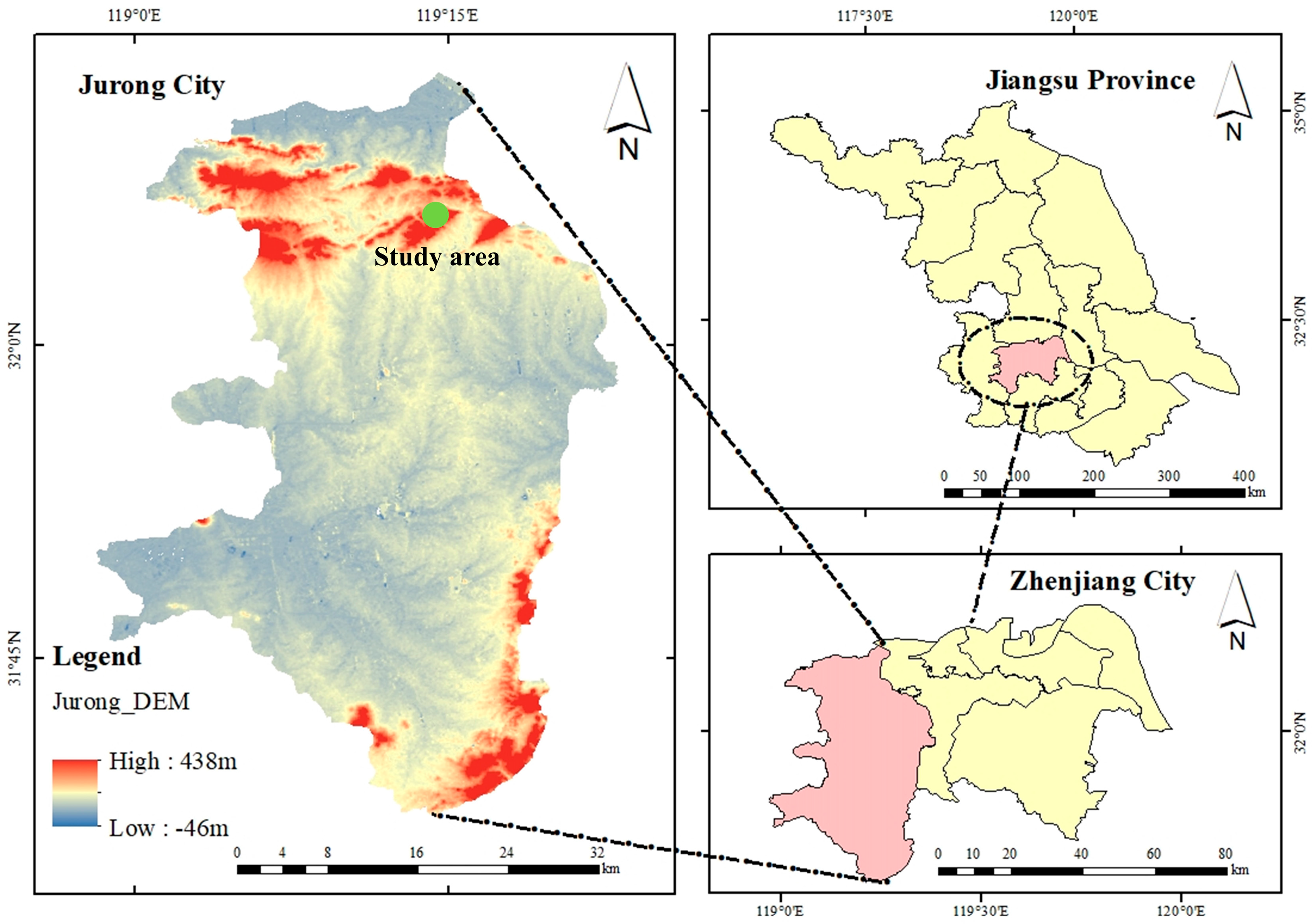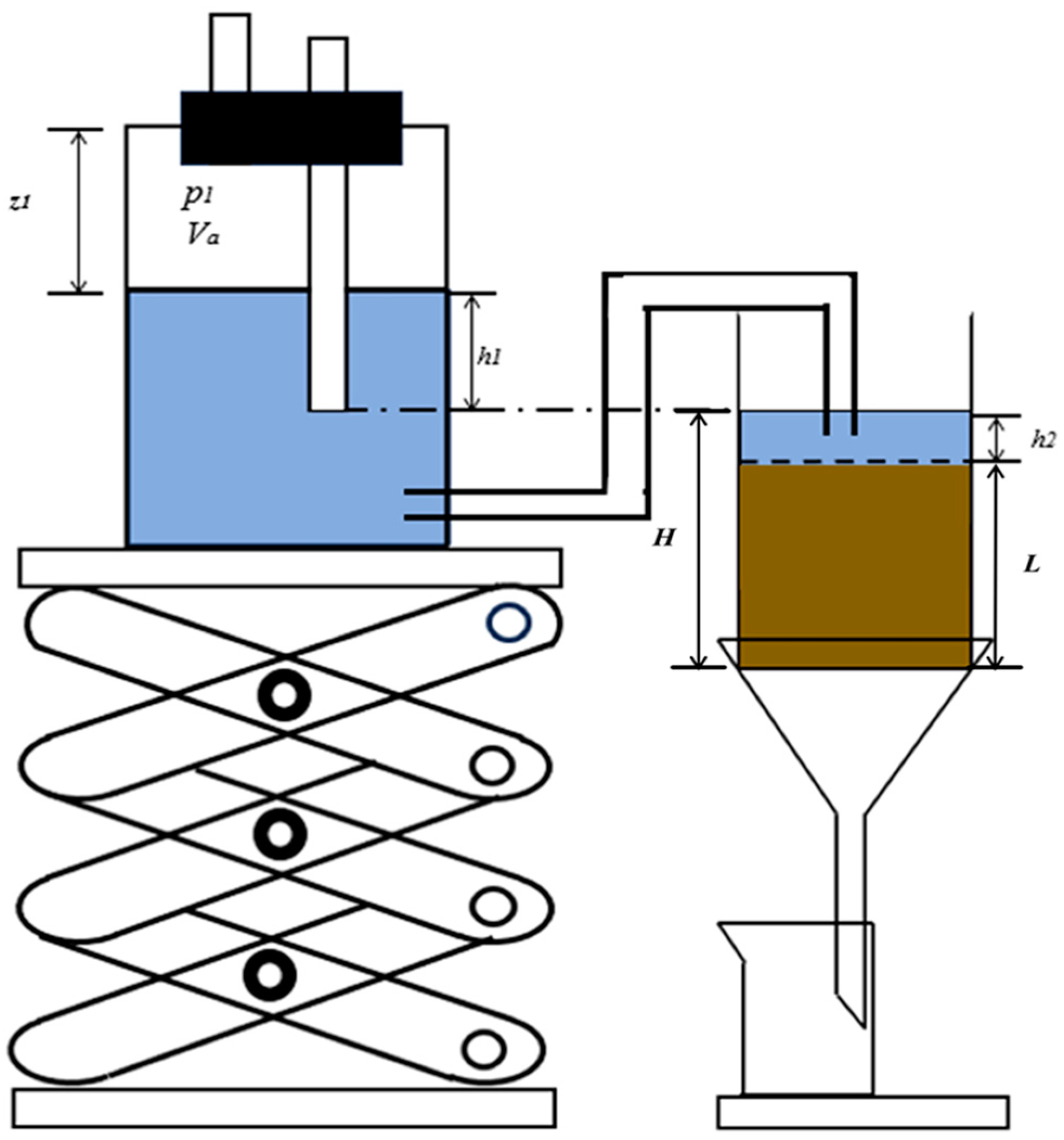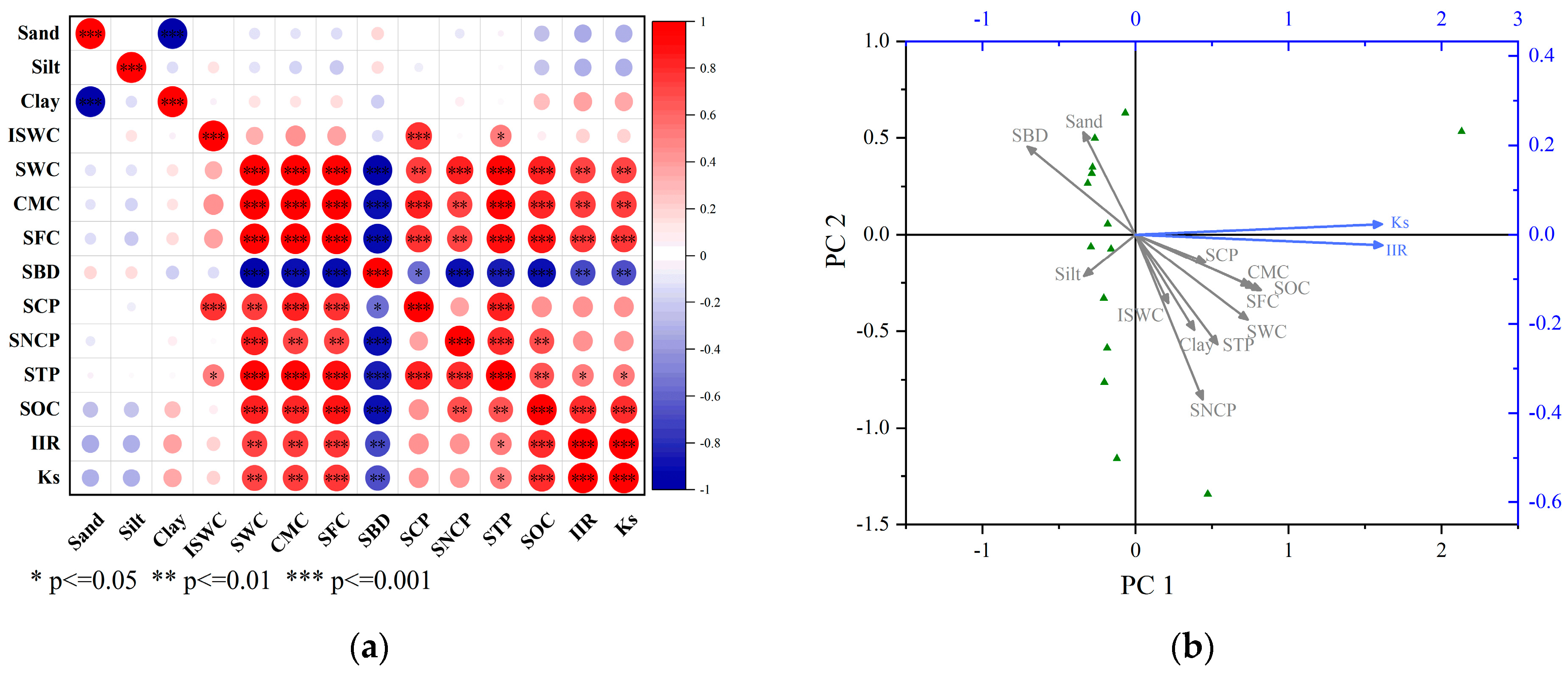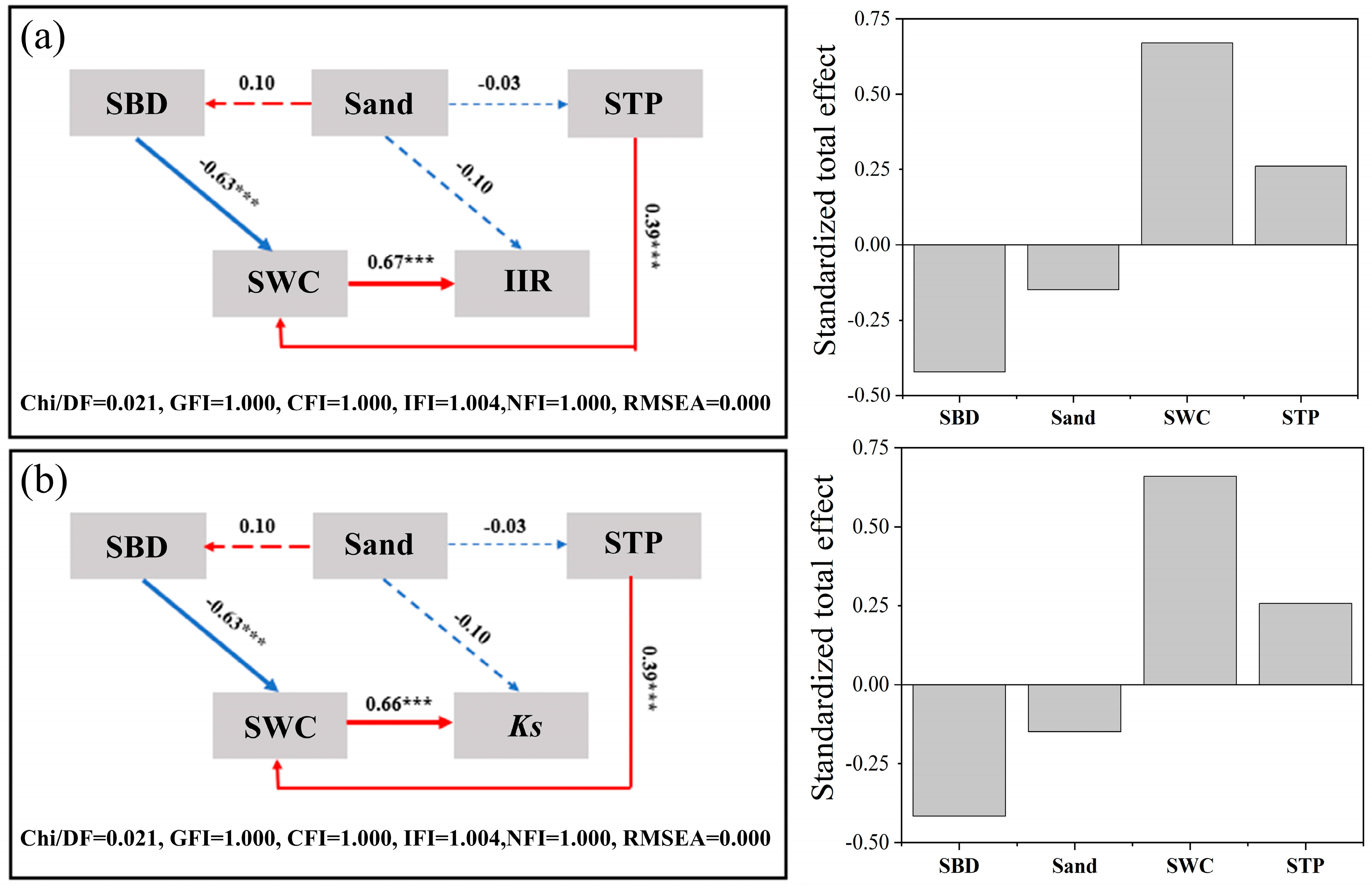Effects of Soil Physical Properties on Soil Infiltration in Forest Ecosystems of Southeast China
Abstract
:1. Introduction
2. Materials and Methods
2.1. The Study Area
2.2. Soil Sample Collection
2.3. Soil Physical Properties Measurement
- M1: mass of dry matter in the sample, g;
- m: amount of sample taken from the specimen, g;
- Wdm: dry matter content of the soil, %;
- ωoc: content of organic carbon in the soil sample, %;
- A: absorbance of the sample abatement solution;
- A0: absorbance of the blank test;
- a: intercept of the calibration curve;
- b: probability of the calibration curve.
2.4. Soil Infiltration Rate Measurement
2.4.1. Initial Infiltration Rate
2.4.2. Saturated Hydraulic Conductivity at 10 °C
2.5. Data Analysis
3. Results
3.1. Comparison of Soil Physical Properties of Different Stands
3.2. Variation Characteristics of Soil Infiltration Properties
3.3. Effects of Soil Physical Properties on Soil Infiltration Ability
4. Discussion
4.1. Most Controlling Factors of SIPs
4.2. Implication
5. Conclusions
Supplementary Materials
Author Contributions
Funding
Data Availability Statement
Conflicts of Interest
References
- Tiemann, A.; Ring, I. Towards ecosystem service assessment: Developing biophysical indicators for forest ecosystem services. Ecol. Indic. 2022, 137, 108704. [Google Scholar] [CrossRef]
- Wu, G.-L.; Cui, Z.; Huang, Z. Contribution of root decay process on soil infiltration capacity and soil water replenishment of planted forestland in semi-arid regions. Geoderma 2021, 404, 115289. [Google Scholar] [CrossRef]
- Yin, X.; Zhao, L.; Fang, Q.; Zi, R.; Fang, F.; Fan, C.; Ding, G. Effects of biochar on runoff generation, soil and nutrient loss at the surface and underground on the soil-mantled karst slopes. Sci. Total Environ. 2023, 889, 164081. [Google Scholar] [CrossRef] [PubMed]
- Yin, C.; Zhao, W.; Pereira, P. Soil conservation service underpins sustainable development goals. Glob. Ecol. Conserv. 2022, 33, e01974. [Google Scholar] [CrossRef]
- Bashir, S.; Javed, A.; Bibi, I.; Ahmad, N. Soil and Water Conservation; Pakistan, University of Agriculture: Faisalabad, Pakistan, 2017; pp. 263–286. [Google Scholar]
- Wang, Q.; Li, F.; Zhao, X.; Zhao, W.; Zhang, D.; Zhou, X.; Sample, D.J.; Wang, X.; Liu, Q.; Li, X.; et al. Runoff and nutrient losses in alfalfa (Medicago sativa L) production with tied-ridge-furrow rainwater harvesting on sloping land. Int. Soil Water Conserv. Res. 2022, 10, 308–323. [Google Scholar]
- Lu, J.; Zhang, Q.; Werner, A.D.; Li, Y.; Jiang, S.; Tan, Z. Root-induced changes of soil hydraulic properties—A review. J. Hydrol. 2020, 589, 125203. [Google Scholar] [CrossRef]
- Zhang, Y.; Tang, Z.; Zhang, J.; Zhang, Z.; Zhang, M. Visualizing preferential flow paths using dye tracer and species diversity theory methods to explore their correlation to soil properties with random forest algorithm. J. Hydrol. 2024, 638, 131570. [Google Scholar] [CrossRef]
- Tang, Z.; Zhang, W.; Chen, J.; Wang, L.; Zhang, Y. Contributions of soil organic carbon-induced root- and soil properties complexity to water flow in eastern China. Sci. Total Environ. 2024, 945, 174125. [Google Scholar] [CrossRef] [PubMed]
- Ma, Y.; Liu, Y.; Tian, L.; Yang, Y.; Long, Y.; Lei, M.; Zhang, Z.; Li, Q.; Zhu, H.; Li, Z. Effects of rainfall pattern and soil surface roughness on surface–subsurface hydrological response and particle size distribution of red soil slope. CATENA 2023, 232, 107422. [Google Scholar] [CrossRef]
- Dharmawan, I.W.S.; Pratiwi; Siregar, C.A.; Narendra, B.H.; Undaharta, N.K.E.; Sitepu, B.S.; Sukmana, A.; Wiratmoko, M.D.E.; Abywijaya, I.K.; Sari, N. Implementation of Soil and Water Conservation in Indonesia and Its Impacts on Biodiversity, Hydrology, Soil Erosion and Microclimate. Appl. Sci. 2023, 13, 7648. [Google Scholar] [CrossRef]
- Abiye, W. Soil and water conservation nexus agricultural productivity in ethiopia. Adv. Agric. 2022, 2022, 8611733. [Google Scholar] [CrossRef]
- He, Z.; Jia, G.; Liu, Z.; Zhang, Z.; Yu, X.; Xiao, P. Field studies on the influence of rainfall intensity, vegetation cover and slope length on soil moisture infiltration on typical watersheds of the Loess Plateau, China. Hydrol. Process. 2020, 34, 4904–4919. [Google Scholar] [CrossRef]
- Zhu, P.; Zhang, G.; Yang, Y.; Wang, C.; Chen, S.; Wan, Y. Infiltration properties affected by slope position on cropped hillslopes. Geoderma 2023, 432, 116379. [Google Scholar]
- Hui, X.; Zhao, H.; Zhang, H.; Wang, W.; Wang, J.; Yan, H. Specific power or droplet shear stress: Which is the primary cause of soil erosion under low-pressure sprinklers? Agric. Water Manag. 2023, 286, 108376. [Google Scholar] [CrossRef]
- Filipović, V.; Defterdarović, J.; Šimůnek, J.; Filipović, L.; Ondrašek, G.; Romić, D.; Bogunović, I.; Mustać, I.; Ćurić, J.; Kodešová, R. Estimation of vineyard soil structure and preferential flow using dye tracer, X-ray tomography, and numerical simulations. Geoderma 2020, 380, 114699. [Google Scholar]
- Ju, X.; Gao, L.; She, D.; Jia, Y.; Pang, Z.; Wang, Y. Impacts of the soil pore structure on infiltration characteristics at the profile scale in the red soil region. Soil Tillage Res. 2024, 236, 105922. [Google Scholar] [CrossRef]
- Liu, S.; Li, S.; Liu, J. Jurin’s law revisited: Exact meniscus shape and column height. Eur. Phys. J. E 2018, 41, 46. [Google Scholar] [CrossRef]
- Rasse, D.P.; Smucker, A.J.M.; Santos, D. Alfalfa root and shoot mulching effects on soil hydraulic properties and aggregation. Soil Sci. Soc. Am. J. 2000, 64, 725–731. [Google Scholar] [CrossRef]
- Basset, C.; Abou Najm, M.; Ghezzehei, T.; Hao, X.; Daccache, A. How does soil structure affect water infiltration? A meta-data systematic review. Soil Tillage Res. 2023, 226, 105577. [Google Scholar]
- Fu, T.; Gao, H.; Liang, H.; Liu, J. Controlling factors of soil saturated hydraulic conductivity in Taihang Mountain Region, northern China. Geoderma Reg. 2021, 26, e00417. [Google Scholar] [CrossRef]
- Delgado-Baquerizo, M.; Reich, P.B.; Trivedi, C.; Eldridge, D.J.; Abades, S.; Alfaro, F.D.; Bastida, F.; Berhe, A.A.; Cutler, N.A.; Gallardo, A.; et al. Multiple elements of soil biodiversity drive ecosystem functions across biomes. Nat. Ecol. Evol. 2020, 4, 210–220. [Google Scholar] [CrossRef] [PubMed]
- Malaeb, Z.A.; Summers, J.K.; Pugesek, B.H. Using structural equation modeling to investigate relationships among ecological variables. Environ. Ecol. Stat. 2000, 7, 93–111. [Google Scholar] [CrossRef]
- Zhu, P.; Zhang, G.; Wang, C.; Chen, S.; Wan, Y. Variation in soil infiltration properties under different land use/cover in the black soil region of Northeast China. Int. Soil Water Conserv. Res. 2024, 12, 379–387. [Google Scholar] [CrossRef]
- Tang, Y.; Liu, X.; Lian, J.; Cheng, X.; Wang, G.G.; Zhang, J. Soil Depth Can Modify the Contribution of Root System Architecture to the Root Decomposition Rate. Forests 2023, 14, 1092. [Google Scholar] [CrossRef]
- Smagin, A.V.; Khakimova, G.M.; Khineeva, D.A.; Sadovnikova, N.B. Gravity factor of the formation of the field and capillary water capacities in soils and artificial layered soil-like bodies. Eurasian Soil Sci. 2008, 41, 1189–1197. [Google Scholar] [CrossRef]
- Zhang, W.; Wang, L.; Tang, Z.; Zhang, Y. Effects of the root system architecture of Pinus taeda and Phyllostachys edulis on the index of hydrological connectivity in subtropical forest ecosystems. Forests 2022, 13, 2008. [Google Scholar] [CrossRef]
- Li, D.; Zhang, S. The influences of sand content and particle size on the desiccation cracks of compacted expansive soil. Adv. Mater. Sci. Eng. 2021, 2021, 7752352. [Google Scholar] [CrossRef]
- Tian, P.; Gong, Y.; Hao, F.; Chen, L.; Yang, Y.; Guo, W.; Wu, H.; Zhang, W. Comparing erosion and rill development processes by simulated upslope inflow in two red soils from subtropical China. CATENA 2022, 213, 106139. [Google Scholar] [CrossRef]
- Germann, P.F. Viscosity—The weak link between Darcy’s law and Richards’ capillary flow. Hydrol. Process. 2018, 32, 1166–1172. [Google Scholar]
- Shi, S.; Zhao, F.; Ren, X.; Meng, Z.; Dang, X.; Wu, X. Soil infiltration properties are affected by typical plant communities in a semi-arid desert grassland in China. Water 2022, 14, 3301. [Google Scholar] [CrossRef]
- Farahani, H.; Jahansoozi, M. Analysis of rural households’ resilience to drought in Iran, case study: Bajestan County. Int. J. Disaster Risk Reduct. 2022, 82, 103331. [Google Scholar]
- Hu, L.T.; Bentler, P.M. Cutoff criteria for fit indexes in covariance structure analysis: Conventional criteria versus new alternatives. Struct. Eq. Model. 1999, 6, 1–55. [Google Scholar]
- Byrne, B.M. Structural Equation Modeling with Lisrel, Prelis, and Simplis: Basic Concepts, Applications, and Programming; Psychology Press: New York, NY, USA, 1998. [Google Scholar] [CrossRef]
- Hooper, D.; Mullen, J.; Hooper, D.; Coughlan, J.; Mullen, M.R. Structural equation modeling: Guidelines for determining model fit. Electron. J. Bus. Res. Methods 2008, 6, 53–60. [Google Scholar]
- Tabachnick, B.G.; Fidell, L.S.; Ullman, J.B. Using Multivariate Statistics; Pearson: Boston, MA, USA, 2013; Volume 6, pp. 497–516. [Google Scholar]
- Chen, L.; Young, M.H. Green-Ampt infiltration model for sloping surfaces. Water Resour. Res. 2006, 42, W07420. [Google Scholar] [CrossRef]
- Liu, Z.-Z.; Yan, Z.-X.; Qiu, Z.-H.; Wang, X.-G.; Li, J.-W. Stability analysis of an unsaturated soil slope considering rainfall infiltration based on the Green-Ampt model. J. Mt. Sci. 2020, 17, 2577–2590. [Google Scholar] [CrossRef]
- de Almeida, W.S.; Panachuki, E.; de Oliveira, P.T.S.; da Silva Menezes, R.; Sobrinho, T.A.; de Carvalho, D.F. Effect of soil tillage and vegetal cover on soil water infiltration. Soil Tillage Res. 2018, 175, 130–138. [Google Scholar]
- Jain, V.; Raj, T. Evaluating the variables affecting flexibility in fms by exploratory and confirmatory factor analysis. Glob. J. Flex. Syst. Manag. 2013, 14, 181–193. [Google Scholar] [CrossRef]
- Ma, D.; He, Z.; Wang, L.; Zhao, W.; Chen, L.; Lin, P.; Zhao, P.; Wang, W.; Gao, Y.; Li, J. Soil water and salt migration in oasis farmland during crop growing season. J. Soil Sediment. 2023, 23, 355–367. [Google Scholar]
- Orzech, K.; Wanic, M.; Załuski, D. The effects of soil compaction and different tillage systems on the bulk density and moisture content of soil and the yields of winter oilseed rape and cereals. J. Agric. Sci. 2021, 11, 666. [Google Scholar] [CrossRef]
- Cui, Z.; Huang, Z.; Liu, Y.; López-Vicente, M.; Wu, G.-L. Natural compensation mechanism of soil water infiltration through decayed roots in semi-arid vegetation species. Sci. Total Environ. 2022, 819, 151985. [Google Scholar] [CrossRef]
- Hasituya; Liu, J.; Liu, T. The Characteristics of Rainfall-Runoff Generation and Its Influencing Factors in a Desert Steppe, China. Sustainability 2023, 15, 15531. [Google Scholar] [CrossRef]
- Zhao, W.; Cui, Z.; Fan, Y.; Cao, Q. Predicting spatial variability of soil bulk density in gravelmulched fields. J. Hydrol. Eng. 2018, 23, 04018022. [Google Scholar]
- Nciizah, A.D.; Wakindiki, I.I. Physical indicators of soil erosion, aggregate stability and erodibility. Arch. Agron. Soil Sci. 2015, 61, 827–842. [Google Scholar] [CrossRef]
- Zhu, F.; Lin, X.; Guan, S.; Dou, S. Deep incorporation of corn straw benefits soil organic carbon and microbial community composition in a black soil of Northeast China. Soil Use Manag. 2022, 38, 1266–1279. [Google Scholar] [CrossRef]
- Steponavičienė, V.; Bogužas, V.; Sinkevičienė, A.; Skinulienė, L.; Vaisvalavičius, R.; Sinkevičius, A. Soil water capacity, pore size distribution, and CO2 emission in different soil tillage systems and straw retention. Plant J. 2022, 11, 614. [Google Scholar]
- Porzig, E.; Seavy, N.; Owens, B.; Gardali, T. Field evaluation of a simple infiltration test and its relationship with bulk density and soil organic carbon in California rangelands. J. Soil Water Conserv. 2018, 73, 200–206. [Google Scholar] [CrossRef]
- Gavrilescu, M. Water, soil, and plants interactions in a threatened environment. Water 2021, 13, 2746. [Google Scholar] [CrossRef]
- Suseela, V.; Tharayil, N. Decoupling the direct and indirect effects of climate on plant litter decomposition: Accounting for stress-induced modifications in plant chemistry. Glob. Chang. Biol. 2018, 24, 1428–1451. [Google Scholar] [CrossRef]
- Jiang, X.J.; Chen, C.; Zhu, X.; Zakari, S.; Singh, A.K.; Zhang, W.; Zeng, H.; Yuan, Z.-Q.; He, C.; Yu, S.; et al. Use of dye infiltration experiments and HYDRUS-3D to interpret preferential flow in soil in a rubber-based agroforestry systems in Xishuangbanna, China. CATENA 2019, 178, 120–131. [Google Scholar] [CrossRef]
- Liu, Y.; Zhang, Y.; Xie, L.; Zhao, S.; Dai, L.; Zhang, Z. Effect of soil characteristics on preferential flow of Phragmites australis community in Yellow River delta. Ecol. Indic. 2021, 125, 107486. [Google Scholar] [CrossRef]
- Chen, J.; Zhu, Z.; Hu, H.; Luo, Z.; Yang, X.; Jia, X.; Fang, P.; Mansour, L. Soil quality assessment of oak forests invaded by moso bamboo (Phyllostachys edulis) in the northern subtropics. Glob. Ecol. Conserv. 2024, 51, e02945. [Google Scholar] [CrossRef]
- Zhou, M.; Hu, H.; Wang, J.; Wang, X.; Tian, Z.; Deng, W.; Wu, C.; Zhu, L.; Lu, Q.; Feng, Y. Effects of nitric acid rain stress on soil nitrogen fractions and fungal communities in a northern subtropical forest, China. Sci. Total Environ. 2023, 856, 158904. [Google Scholar] [CrossRef] [PubMed]
- Xiao, L.; Li, C.; Cai, Y.; Zhou, T.; Zhou, M.; Gao, X.; Zhou, Y. Interactions between soil properties and the rhizome-root distribution in a 12-year Moso bamboo reforested region: Combining ground-penetrating radar and soil coring in the field. Sci. Total Environ. 2021, 800, 149467. [Google Scholar] [PubMed]
- Xiao, H.; Liu, J.; Li, F. Both alpha and beta diversity of nematode declines in response to moso bamboo expansion in south China. Appl. Soil Ecol. 2023, 183, 104761. [Google Scholar] [CrossRef]
- Wu, W.; Chen, G.; Meng, T.; Li, C.; Feng, H.; Si, B.; Siddique, K.H. Effect of different vegetation restoration on soil properties in the semi-arid Loess Plateau of China. CATENA 2023, 220, 106630. [Google Scholar] [CrossRef]
- Xu, Q.-F.; Liang, C.-F.; Chen, J.-H.; Li, Y.-C.; Qin, H.; Fuhrmann, J.J. Rapid bamboo invasion (expansion) and its effects on biodiversity and soil processes. Chin. J. Plant Ecol. 2015, 39, 110–124. [Google Scholar] [CrossRef]





Disclaimer/Publisher’s Note: The statements, opinions and data contained in all publications are solely those of the individual author(s) and contributor(s) and not of MDPI and/or the editor(s). MDPI and/or the editor(s) disclaim responsibility for any injury to people or property resulting from any ideas, methods, instructions or products referred to in the content. |
© 2024 by the authors. Licensee MDPI, Basel, Switzerland. This article is an open access article distributed under the terms and conditions of the Creative Commons Attribution (CC BY) license (https://creativecommons.org/licenses/by/4.0/).
Share and Cite
Wang, D.; Chen, J.; Tang, Z.; Zhang, Y. Effects of Soil Physical Properties on Soil Infiltration in Forest Ecosystems of Southeast China. Forests 2024, 15, 1470. https://doi.org/10.3390/f15081470
Wang D, Chen J, Tang Z, Zhang Y. Effects of Soil Physical Properties on Soil Infiltration in Forest Ecosystems of Southeast China. Forests. 2024; 15(8):1470. https://doi.org/10.3390/f15081470
Chicago/Turabian StyleWang, Di, Jinhong Chen, Zhiying Tang, and Yinghu Zhang. 2024. "Effects of Soil Physical Properties on Soil Infiltration in Forest Ecosystems of Southeast China" Forests 15, no. 8: 1470. https://doi.org/10.3390/f15081470




